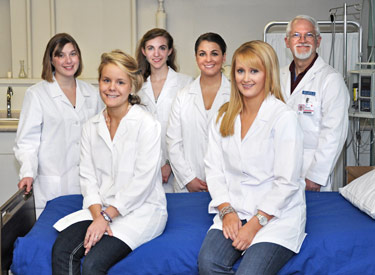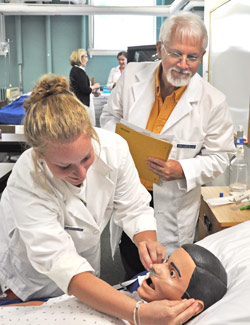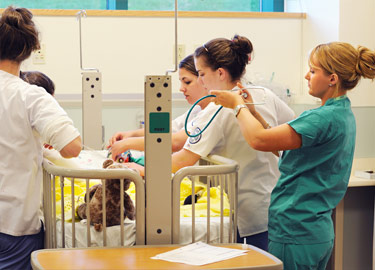
CSC Nursing Department Joins Dartmouth-Hitchcock Medical Center in Interprofessional Training for Students Across Health Care Fields
To err is human, and yet medical errors can be harmful or even fatal for patients. Recent research shows that up to 80 percent of medical errors are caused by poor communication among professionals in different health care disciplines. In response, Colby-Sawyer College and Dartmouth-Hitchcock Medical Center (DHMC) are training the next generations of health care professionals to work together to ensure safer, more effective patient care.
As the undergraduate nursing education program for DHMC, Colby-Sawyer's Nursing Department is collaborating with Dartmouth Medical School and The Dartmouth Institute to offer opportunities for their students to train together. These programs allow student nurses and medical and public health students to learn about each others' roles and areas of expertise. Within safe educational settings, these students learn to work together toward the shared goal of providing excellent patient care.
“Interprofessional education for the health professions is an emerging trend,” says Susan Reeves, chair of the Nursing Department and the Gladys A. Burrows Distinguished Professor of Nursing at Colby-Sawyer. “Colby-Sawyer College, Dartmouth Medical School and Dartmouth-Hitchcock Medical Center are definitely on the cutting edge of this evolution.”
Learning to Work as Effective Teams
The most intensive and successful example of their interprofessional training is the annual CLARION Root Cause Analysis (RCA) Competition, which has brought Colby-Sawyer student nurses, medical students from Dartmouth Medical School, and public health students from The Dartmouth Institute together for the past five years. Prior to the event, the students receive training in root cause methods and analysis from Professor Reeves and Greg Ogrinc, M.D., who directs the medical school's Office on Research in Innovation in Medical Education.
For the 2010 competition, six Colby-Sawyer student nurses participated as part of three-person teams that included a medical student and a public health student. The teams were given a fictional case and had to identity the medical errors and their root causes, as well as create action plans to assist medical professionals in preventing these errors in the future and lead to better outcomes for their patients. Action plans must include supporting evidence from literature reviews; recommendations for ways to implement the changes; and methods for measuring the plans' effectiveness.
The Colby-Sawyer student nurses included Carly Sanginetti, Abbie Cheney, Jim Godfrey, Hillary Hudson, Beth Kucia and Ashley Scott. To prepare for the competition, each team member became familiar with the case and formulated their own analysis of the root causes for the medical errors. The teams then held group meetings to discuss their perspectives and educate one another about their respective roles as nurse, physician and health policy coordinators.

Jim Godfrey, a non-traditional student from Lebanon, N.H., was fascinated to see how each of his team member's diverse backgrounds gave them familiarity and expertise with very different aspects of the case study.
“My team started meeting early and weekly for long sessions, coming to each with lots of ideas. This immersion strategy worked well for all of us,” he says. “My group was easy-going and conversational, questioning each other and really listening. We were open to learning from each other and respectful of each others' strengths and points of view about priorities. We enjoyed the process of making a coherent recommendation and presentation from our differing perspectives.”
As his team's student nurse, Godfrey interviewed three nurses with expertise in different areas relevant to the case. He employed techniques he had used in his previous career as a computer programmer and analyst, breaking the case study into discrete events that could be evaluated, categorized and prioritized separately, and then regrouped to guide the team's focus and recommendations.
One team member, Mabel, a master's student at The Dartmouth Institute for Health Policy and Clinical Practice, contacted community health organizations in the actual city of their fictional hospital, and incorporated their input into the team's recommendations. Mabel was also an “organizational guru and PowerPoint whiz,” according to Godfrey, and she kept the team on track and focused on the presentation. Jared, a medical student with a keen interest in and good contacts in patient advocacy, contributed key ideas to their recommendations as well.
“We were a very good fit for a group project. We each brought a lot to the project, and learned from each other's very different training, contacts and skills,” Godfrey adds.
Carly Sanginetti of Pittsfield, Mass., whose role on her team was to offer input in keeping with the standards of nursing practice, says the experience showed her that professionals bring a wide range of perspectives to their roles. “Because we all come from different areas of health care, it was hard in the beginning to see eye to eye on many issues,” she says. “This was a good thing, as it gave each of us an appreciation and understanding of why other members of the health care community work the way they do and view things differently.”
Since the case focused on nurse and patient interaction, Sanginetti was able to provide her team members with insights into the nurse's role in these kinds of situations and the standard protocols that nurses follow.
“I had to evaluate whether or not our recommendations in the case would be practical for a nurse to implement in her practice,” Sanginetti says. “From this process, I learned the value of collaborating with different health professionals, which will be a routine occurrence in my nursing career. I also learned to understand the broad viewpoints of how physicians and health policy coordinators see patient care, and how they differ and agree with my own.”
At the competition, each team gave 10-minute presentations, followed by questions from a panel of judges. The judges included the Medical and Administrative Directors of the DHMC Center for Patient Safety; a leader for Root Cause Analysis Processes; and a member of last year's winning team, who is now a health care engineering fellow at the Veterans Medical Center in Boston.

Sanginetti's team took first place in the DHMC competition, which she attributes to her team's ability to accept each others' differing viewpoints. “Once we were able to overcome the hurdles, we learned to be receptive to the role of each and every health professional,” she says. “We recognized that had the team of medical personnel collaborated in our case study, the errors would have been minimized or possibly not occurred. With this, we realized that we must do the same… collaborating towards success as a team.”
Professor Reeves was deeply impressed with the student nurses' performances in the competition. “The Colby-Sawyer students were simply outstanding in their presentations,” she says “Their presentations were informative, clear, compelling and innovative. Perhaps most impressive was their poise when answering the tough questions from the judges.”
Through these experiences, students learn to participate in competition, to work with team dynamics, and to understand others professionals' unique backgrounds and how to utilize their respective strengths in different medical settings, according to Reeves.
“The secondary gain is to simply get to know other students from different professions. It breaks the ice, and soon the student nurses think, 'If it's this easy for me to talk to a medical student, it should be easy for me to talk to a physician,'” adds s Reeves, whose dissertation research focused on medical error. “It's amazing how fear of talking to physicians is still present. If we're doing something to break down the barriers that make people anxious about talking to other professionals about a change in a patient's condition or a question with an order that was written, then it's all worth it.”
Colby-Sawyer student nurses and Dartmouth medical students have also attended a workshop at New London Hospital to learn about the hospital's successful efforts to improve patient care. The Nursing Department at Colby-Sawyer has also incorporated interprofessional training techniques into its student nurses' clinical rotations at DHMC. Following their rotations, students are asked to provide recommendations on how various departments can improve their patient care. In the upcoming year, student nurses will also work alongside medical students, nurse practitioner students and physician assistant students in primary care community practices situated in underserved areas.
Seeing the Big Picture in Health Care
Jim Godfrey believes his courses at Colby-Sawyer and clinical rotations at DHMC have laid a strong foundation for his future practice, while interprofessional training is preparing him well for working in all kinds of settings with professionals from across the health care fields.
“In my courses and clinical work as a nursing student, I have been well supported by my faculty and the DHMC nurses I have worked under,” Godfrey explains. “I've also been impressed by all the health care providers at DHMC, who have not just tolerated me as a student, but have really welcomed me. It's truly a teaching hospital; they embrace the role.
In the RCA competition, Godfrey says he and his team members viewed each other as peers. “We were all students, taking on our professional roles. We were not supervised or directed, but had many resources for assistance. Even though it was a fictional case set in a fictional hospital, we made professional contacts and brought the information together,” he says. “We treated each other respectfully, but as professionals in our separate realms wrestling together with issues and how best to improve processes. It gave me new insight into how working in health care might be when I am no longer a student–the freedom and the responsibility.”
For Godfrey, interprofessional training experiences has helped him to see the bigger picture of the health care field he will soon join as a professional, where he will work cooperatively with other professionals every day to provide the best possible care for patients.
“It gave me a hopeful vision of the benefits of interpersonal and interprofessional teamwork, the opportunities for bringing forth what I have learned, and for learning something new,” he concludes. “It was all the more fascinating for me to see the five other presentations (at the competition). How intriguing to see such a variety of priorities and creative proposals to address problems in the same case study. There is an art to the science of health, many perspectives and creative solutions, and professionals in all fields can make valuable contributions.”


